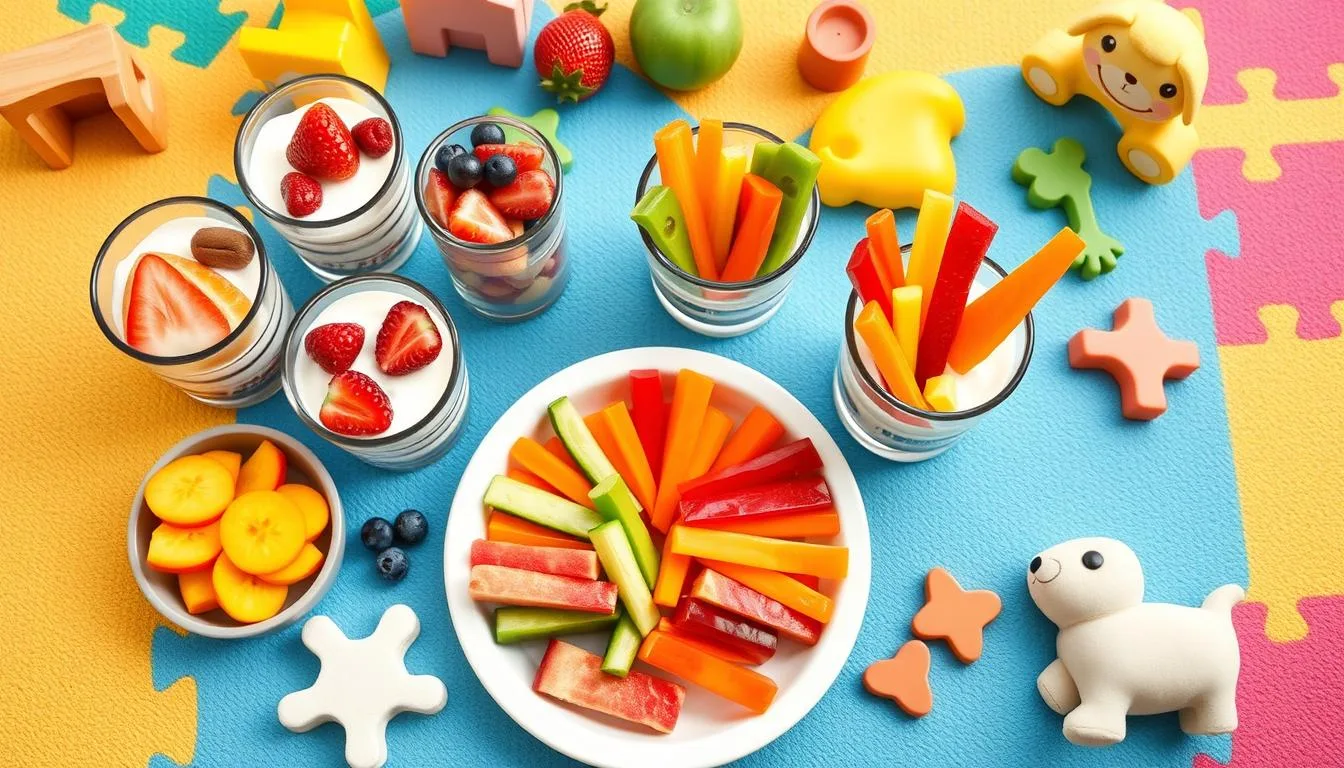Finding Healthy Sweet Treats for Toddlers can be tough for parents. It’s important to help shape their eating habits early on. This sets the stage for their future food choices and health.
Toddlers need snacks often because their stomachs are small and they are full of energy. The first two years are a great time to introduce different tastes and textures. This helps them develop good eating habits for life.
Choosing healthy snacks is more than just filling their bellies. These snacks give them the proteins, fats, and carbs they need to grow and learn. They are key to your toddler’s development.
Key Takeaways
- Toddlers need frequent nutritious snacks to support their growth
- The 6-24 month period is crucial for establishing food preferences
- Snacks should be nutrient-dense and diverse
- Portion control is key to developing healthy eating habits
- Variety helps toddlers understand hunger and fullness cues
Table of Contents
Understanding Toddler Nutrition and Snacking Needs
Parenting a toddler can be tough. Their growth depends on good nutrition and a regular eating schedule. Snacks full of nutrients are key for their health and growth.
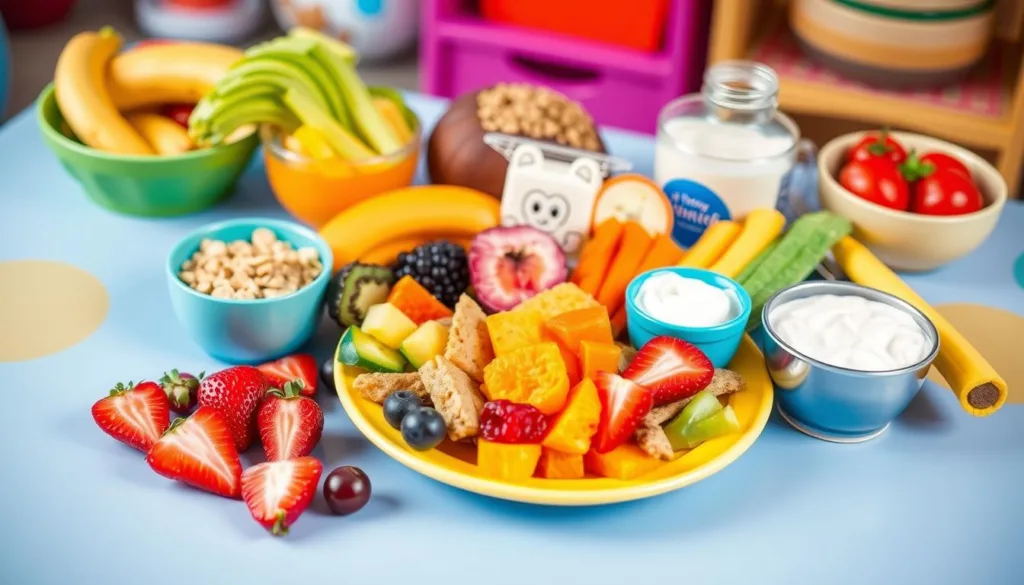
Toddlers need different foods than babies and older kids. Their small stomachs need lots of small, nutritious meals and snacks all day.
The Importance of Regular Snacking
Snacking is vital for toddlers because:
- It keeps their energy up
- It gives them the nutrients they need to grow
- It helps keep their blood sugar steady
- It stops them from getting too hungry or cranky
The key is to view snacks as mini-meals, not just quick treats.
Nutrient Requirements for Growing Toddlers
Your toddler’s diet should have the right mix of nutrients:
- Proteins: For building muscles
- Healthy Fats: Important for brain growth
- Carbohydrates: Their main energy source
- Vitamins and Minerals: Found in fruits and veggies
The “Flavor Window” Opportunity
Between 6-24 months, kids have a special “flavor window.” This is when they can try new tastes. It’s a great time to help them develop a varied diet and avoid being picky.
Starting a good relationship with food begins with choosing healthy snacks. These snacks help your toddler grow and develop well.
Essential Guidelines for Choosing Healthy Sweet Treats
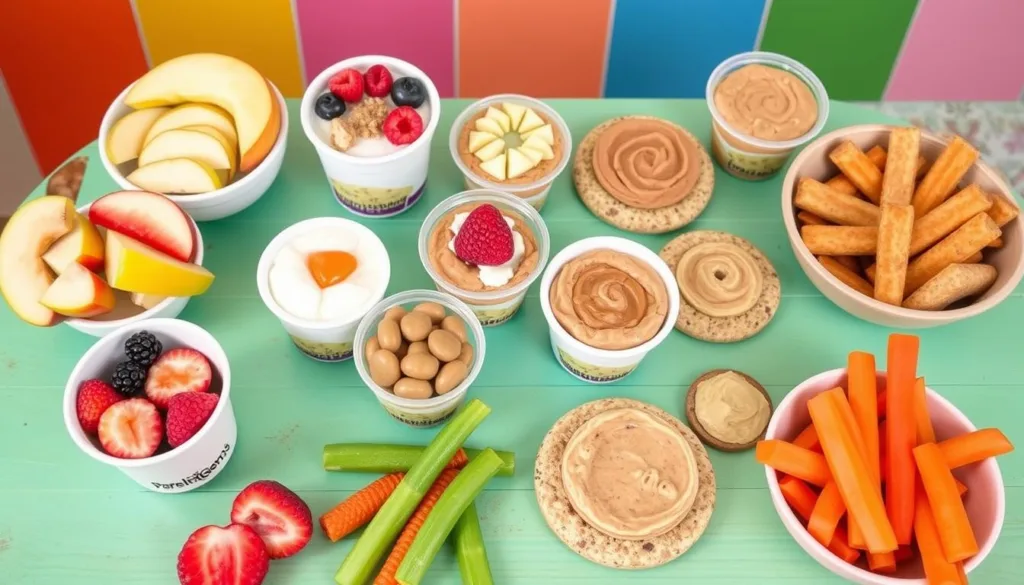
Choosing the right snacks for your toddler is both an art and a science. You want snacks that are tasty and full of nutrients. These snacks should help your child grow and develop well.
“Snacks are more than just food – they’re an opportunity to nourish and explore!” – Pediatric Nutrition Expert
When picking snacks for toddlers, go for whole foods. They offer great taste and lots of nutrients. Make sure your snacks include foods from different groups for a balanced diet.
Key Considerations for Nutritious Snacks
- Prioritize unprocessed, natural ingredients
- Balance protein, healthy fats, and complex carbohydrates
- Limit added sugars
- Ensure age-appropriate portion sizes
- Make snacks visually appealing
The flavor window in toddlerhood is key for learning about different tastes. By introducing many whole foods early, you help your child develop good eating habits for life.
Nutrient Breakdown Guidelines
| Nutrient Group | Recommended Percentage | Examples |
|---|---|---|
| Carbohydrates | 45-65% | Fruits, whole grains, vegetables |
| Proteins | 10-30% | Eggs, Greek yogurt, nut butters |
| Healthy Fats | 25-35% | Avocados, nuts, olive oil |
Remember, balanced snacks keep blood sugar stable and prevent afternoon tantrums. Try to include foods from at least two groups in each snack for the best nutrition.
Safety Tips
- Avoid potential choking hazards
- Introduce new foods gradually
- Watch for allergic reactions
- Supervise snack time
By carefully choosing snacks, you’re not just feeding your toddler. You’re also setting them up for a lifetime of healthy eating.
Natural Sweeteners and Their Benefits for Toddlers
Finding healthy sweeteners for toddlers can be tough. Parents look for natural options that taste good and are good for their kids. It’s important to know which sweeteners are safe and healthy for toddlers.
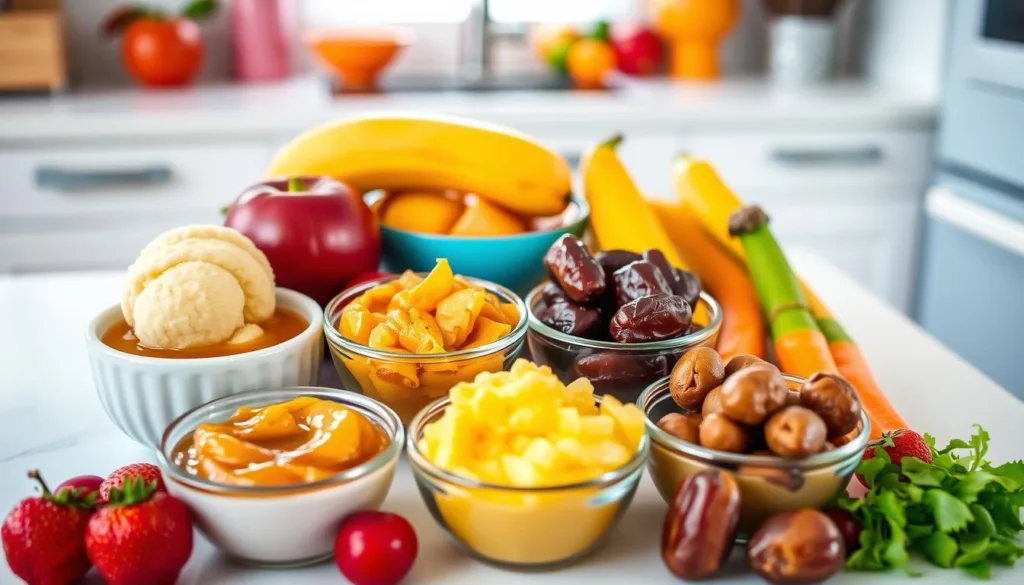
Safe Natural Sweetener Options
There are many natural sweeteners that are good for toddlers:
- Maple syrup: Packed with zinc and manganese
- Stevia: Zero-calorie and low glycemic index
- Coconut sugar: Rich in essential minerals
- Mashed fruits: Natural sweetness with added nutrients
“Small, thoughtful changes in sweetening can reduce unnecessary sugar intake” – Pediatric Nutrition Expert
Sweeteners to Avoid
Not all sweeteners are safe for toddlers. Artificial sweeteners and processed sugars can be harmful. The American Heart Association says kids under two should avoid added sugars.
| Sweetener Type | Recommendation |
|---|---|
| Refined Sugar | Avoid completely |
| Artificial Sweeteners | Not recommended |
| Agave Nectar | Use sparingly |
Portion Control Guidelines
It’s important to control how much kids eat. The American Academy of Pediatrics says kids should have less than 10% of their calories from added sugars. For toddlers, this means:
- Small servings of natural sweeteners
- Gradual reduction of sweetness in snacks
- Allowing toddlers to self-regulate intake
Remember, moderation is key in introducing natural sweeteners to your toddler’s diet.
Fruit-Based Sweet Treats and Creative Serving Ideas
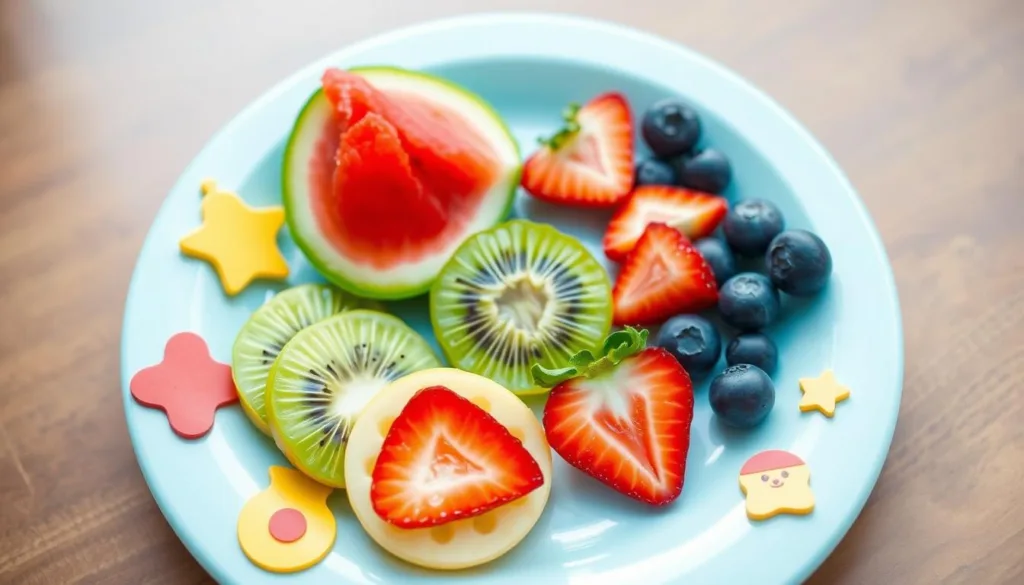
Turning fruit snacks into fun desserts can make mealtime exciting for your toddler. Kid-friendly fruits are a great way to offer sweet treats that are also good for them.
How you present food matters a lot for young kids. Here are some fun ways to serve fruits:
- Fruit kebabs with colorful fruit chunks
- Frozen fruit pops using ripe berries
- Yogurt parfaits with layered fruit
- Smoothies blended with mixed fruits
Being creative with fruits is key. Use cookie cutters for fun shapes or make fruit faces. Pair fruits with Greek yogurt for snacks that are both tasty and filling.
“Eating fruits can be a delightful game for children when presented creatively!” – Pediatric Nutritionist
Try new fruits to broaden your toddler’s taste. Blackberries, raspberries, and pineapple are tasty and full of nutrients.
- Strawberries: Rich in vitamin C
- Blueberries: Packed with antioxidants
- Bananas: Great source of potassium
Introduce new fruits slowly and make it fun. Your excitement can help your toddler love healthy food for life.
Healthy Sweet Treats for Toddlers: Easy No-Bake Options
Discovering quick and nutritious no-bake snacks is a big help for busy parents. These simple, wholesome options make snacking fun and healthy for toddlers.
Quick Preparation Methods
Making no-bake snacks for your toddler is easy. Here are some quick ideas:
- Energy bites with dates and nuts (ready in just 20 minutes)
- Yogurt bark with fresh fruit toppings
- Chia seed puddings
- Homemade trail mix
Smart Food Storage Tips
Keeping snacks fresh is key. Most no-bake snacks can be stored safely:
- Refrigerate in airtight containers
- Most treats last 3-5 days in the fridge
- Energy bites can be frozen for up to 3 months
Travel-Friendly Snack Solutions
When you’re on the move, pack these convenient snacks:
- Fruit and cheese boxes
- Whole grain crackers with nut butter
- Insulated containers to keep perishables fresh
Pro tip: Customize your energy bites with optional add-ins like chia seeds, cocoa powder, or cinnamon for extra nutrition!
Here’s a simple energy bite recipe:
- 1 cup pitted medjool dates
- 1/4 cup peanut butter
- 2/3 cup quick oats
- 1/4 cup cashews
- 1 tsp vanilla extract
- 1/4 cup chocolate chips
These no-bake snacks make about 12 bites. Each bite has about 150 calories. They’re a great nutritious treat for your little one.
Yogurt-Based Desserts and Frozen Treats
Discover delightful yogurt-based desserts that pack a nutritional punch for your little ones! Probiotic snacks can be both delicious and healthy. They offer calcium-rich foods that support your toddler’s growth and development.
“Frozen treats can be a fun and nutritious way to keep kids excited about healthy eating!”
Creating healthy frozen desserts at home is easier than you might think. Here are some exciting options to try:
- Frozen Yogurt Bites: A perfect calcium-rich snack that takes just 10 minutes to prepare
- Yogurt Parfaits: Layer with fresh fruits and a drizzle of honey
- Dairy alternatives for special dietary needs
For parents seeking versatile dairy alternatives, coconut yogurt offers an excellent option. These healthy frozen desserts can be customized with various mix-ins like berries, goji berries, or even chocolate chips.
| Nutritional Highlights | Per Serving |
|---|---|
| Calories | 114-120 kcal |
| Protein | 3-4g |
| Calcium | 64-81mg |
Pro tip: Use thick Greek yogurt or coconut milk for the creamiest texture. These treats can be stored in the freezer for up to two months, making meal prep a breeze!
- Gluten-free
- Refined sugar-free
- Kid and toddler-friendly
Remember, homemade yogurt-based treats allow you to control ingredients. You can create nutritious snacks your toddler will love.
Nutritious Baked Goodies for Little Ones
Turning your kitchen into a healthy baking spot for toddlers is fun and easy. Choose whole grain snacks that are tasty for both kids and adults. You can make yummy, sugar-free treats that are good for them.
Baking for toddlers is more than just yummy food. It’s about giving them healthy, growing foods. Kid-friendly recipes can make simple ingredients into superfoods.
Simple Baking Tips
- Use mini muffin tins for perfect toddler-sized portions
- Involve children in safe, supervised baking activities
- Measure ingredients precisely for consistent results
- Allow baked goods to cool completely before serving
Make-Ahead Solutions
Preparing healthy baked treats ahead of time saves time. It makes sure your kids always have a healthy snack. Here are some tips:
- Batch bake and freeze individual portions
- Label containers with preparation dates
- Store in airtight containers
Ingredient Substitutions
| Original Ingredient | Healthy Substitution |
|---|---|
| White flour | Whole wheat flour or almond flour |
| Sugar | Mashed bananas or applesauce |
| Oil | Greek yogurt or pureed fruits |
“Healthy baking is about making smart choices that nourish your child’s body and delight their taste buds.” – Pediatric Nutritionist
With these tips, you can make healthy baked treats. They support your toddler’s growth and introduce them to new tastes and textures.
Special Occasion Treats That Keep It Healthy
Celebrating special moments with toddlers doesn’t mean you have to give up on nutrition. You can make healthy celebrations both tasty and good for you. This turns festive snacks into fun, healthy moments.
Making low-sugar desserts that look great and are good for you is simpler than you think. Here are some creative ideas for treats that are safe for all and will make everyone happy:
- Watermelon “Cake” with Yogurt Frosting
- Stack watermelon slices
- Top with Greek yogurt cream
- Decorate with fresh berries
- Vegetable-Based Cupcakes
- Carrot muffins with cream cheese topping
- Zucchini cupcakes with natural frosting
Using natural food coloring can make your treats pop. Try beet juice for pink or spinach for green. This way, your desserts are both colorful and healthy.
“Healthy treats can be fun, colorful, and delicious for toddlers!” – Pediatric Nutrition Expert
If you’re dealing with allergies, here are some safe options:
- Seed-based treats
- Coconut flour cupcakes
- Oat flour cookies
| Treat Type | Nutritional Benefit | Preparation Time |
|---|---|---|
| Fruit Skewers | High in Vitamins | 10 minutes |
| Vegetable Muffins | Rich in Fiber | 30 minutes |
| Yogurt Parfaits | Protein-Packed | 15 minutes |
The secret to great festive snacks is being creative, focusing on nutrition, and having fun. Your toddler will love these healthy, tasty treats that make every event special!
Safety Considerations and Allergy Awareness
Keeping your little ones safe while enjoying treats is important. You need to know about food allergies and choking hazards. This is key for parents in the world of toddler nutrition.
Dealing with food allergies can be tough. Parents should watch out for common allergens like:
- Nuts
- Eggs
- Dairy products
- Soy
- Wheat
*Introducing new foods one at a time helps identify potential allergic reactions quickly and safely.*
Choking hazards are another big worry for parents looking for safe snacks. The CDC has tips to prevent choking:
- Cut round foods like grapes into quarters
- Avoid hard, sticky candies
- Supervise children during meal times
- Prepare soft, easy-to-chew foods
The American Heart Association has rules for kids’ sugar intake. They say kids aged 2-18 should have no more than 25 grams of added sugar daily.
| Allergen-Free Snack Options | Safety Features |
|---|---|
| SkinnyPop Mini Popcorn Cakes | Big Nine-free, Low sugar |
| Daiya Homestyle Ranch Dressing | Dairy-free, Nut-free, Soy-free |
Always be careful. Read labels well, introduce foods slowly, and talk to doctors if you’re unsure about allergies or nutrition.
Conclusion
Creating healthy treats for toddlers is more than just planning meals. It shapes their food habits for life. It’s key to offer a variety of foods that help them grow and learn to eat well.
Parents need to be patient and creative when introducing new foods. Every child is different, and making food a positive experience takes time. Choose whole foods that are good for them and make meals fun.
Choosing healthy snacks is crucial for your toddler’s health in the long run. Use ingredients that are good for them, avoid too much sugar, and make food fun. Getting advice from nutrition experts can help meet your child’s needs.
The journey of teaching your toddler to enjoy healthy treats is special. It’s about building trust, exploring new tastes, and making memories. These moments help your child grow physically and emotionally.
FAQ
How often should I offer snacks to my toddler?
Toddlers need 2-3 snacks a day, between meals. Their small stomachs and fast growth mean they need snacks often. Snacks should be nutrient-rich to keep energy up and support growth.
Try to give snacks every 2-3 hours. This helps them not replace meals but add to them.
What are the best nutrient-dense snacks for toddlers?
Look for snacks with proteins, healthy fats, and carbs. Good choices are avocado slices, nut butters (if no allergies), and full-fat yogurt with fruit. Also, cheese cubes, hard-boiled eggs, and veggie sticks with hummus are great.
These foods are full of nutrients that help with growth and brain development.
How can I make snacks more appealing to my toddler?
Make snacks fun! Use fun shapes and colors. Try fruit kebabs, cut fruits into shapes, or make faces on plates.
Involve your toddler in making food. This makes them more excited to try new things.
What are some safe natural sweeteners for toddlers?
Safe sweeteners are mashed bananas, dates, unsweetened applesauce, and a little honey (for kids over 12 months). Avoid artificial sweeteners. Whole fruit purees are best because they’re sweet and full of nutrients.
How do I prevent choking when preparing toddler snacks?
Cut foods into small pieces. Avoid round, hard foods like whole grapes. Cut them into quarters and remove seeds.
Make sure pieces are no bigger than 1/2 inch. Always watch while they eat and introduce new foods slowly. Be careful with nuts, hard raw veggies, and sticky foods.
Can I prepare snacks in advance?
Yes! Many snacks can be made ahead and stored safely. Try no-bake energy balls, frozen yogurt pops, and homemade trail mixes.
Most snacks can be stored in airtight containers in the fridge for 3-5 days. Use insulated containers with ice packs for travel.
How can I introduce new flavors to my toddler?
Use the “flavor window” between 6-24 months. Offer different tastes and textures, one new food at a time. Be patient and keep trying.
Make trying new foods a fun, stress-free experience.
Are there healthy alternatives to processed sweet treats?
Yes! Choose whole foods like fresh fruits, yogurt parfaits, and homemade fruit popsicles. Baked goods made with whole grains and natural sweeteners are also good.
These options are nutritious and satisfy sweet cravings without added sugars or artificial ingredients.

